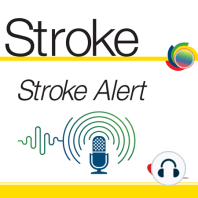31 min listen
Stroke Alert March 2022
FromStroke Alert
ratings:
Length:
35 minutes
Released:
Mar 17, 2022
Format:
Podcast episode
Description
On Episode 14 of the Stroke Alert Podcast, host Dr. Negar Asdaghi highlights two articles from the March 2022 issue of Stroke: “Natural Course of Cerebral Cavernous Malformations in Children” and “Direct Oral Anticoagulants Versus Warfarin in Cerebral Venous Thrombosis (ACTION-CVT).” She also interviews Dr. Mohammad Anadani about his article “Magnitude of Blood Pressure Change After Endovascular Therapy and Outcomes.” Dr. Negar Asdaghi: 1) Are direct oral anticoagulants a reasonable alternative to warfarin for treatments of patients with cerebral venous thrombosis? 2) What are the predictors of first and recurrent intracerebral hemorrhage in patients with cerebral cavernous malformation? 3) Is there an optimal blood pressure target after successful endovascular thrombectomy? We have the answers and much more in today's podcast. This is the latest in Stroke. Stay with us. Dr. Negar Asdaghi: Welcome to another incredibly informing Stroke Alert Podcast. My name is Negar Asdaghi. I'm an Associate Professor of Neurology at the University of Miami Miller School of Medicine and your host for the monthly Stroke Alert Podcast. The March 2022 issue of Stroke includes a number of papers published in conjunction with their oral presentation at the International Stroke Conference in New Orleans, from contemporary trends in the nationwide incidence of primary intracerebral hemorrhage, to disparities in Internet use among U.S. stroke survivors' implication for telerehabilitation during COVID-19 and beyond. I encourage you to review these timely topics in addition to listening to our podcast today. Later, in our interview section, I discussed the optimal blood pressure goal after endovascular therapy and the results of a subgroup analysis of the BP-TARGET randomized trials with Dr. Mohammad Anadani from the Department of Neurology at Washington University in St. Louis. But first with these two articles. Dr. Negar Asdaghi: Cerebral cavernous malformations, also referred to as cavernous angiomas, cavernomas, cav mals, or CCMs, are angiographically occult, low flow, vascular lesions with no large arterial inflow or venous outflow vessels. These are clusters of dilated sinusoidal vascular channels that are aligned by a single layer of endothelium without the normal surrounding vascular smooth muscles, and they lack the normal tight junctions between their endothelial cells. Cavernomas can be found in both children and adults. So, the question is, how do these lesions present, especially in children, and what is their natural course? Now, before we answer these questions, let's review a few important points about cavernomas and what is known about these lesions in the literature. Number one, cavernomas are acquired lesions. Although initially thought to be congenital, they're now known to be acquired as comparing by many reports of patients with normal MRI findings, who later developed a CCM. Number two, they're not always benign. While most of them can have a benign course, cerebral cavernomas can be a cause for headaches, seizure disorders and intracerebral hemorrhage, which is, of course, their most feared complication. Dr. Negar Asdaghi: Number three, though CCMs are rare vascular disorders with a prevalence of 0.6% in children and young adults, about a quarter of patients with a confirmed diagnosis of cerebral cavernous malformation are under the age of 18. And number four and finally, data seem to suggest that the risk of hemorrhage is potentially higher in the pediatric population than their adult counterparts. So, determining the natural course of CCMs and predictors of intracerebral hemorrhage is important for all patients, but especially important in the pediatric population. Now, in the current issue of the journal, in the paper titled "Natural Course of Cerebral Cavernous Malformations in Children: A Five-Year Follow-Up Study," a German group of
Released:
Mar 17, 2022
Format:
Podcast episode
Titles in the series (39)
Stroke Alert September 2021: Monthly summary & analysis of selected research published in the Stroke journal by Stroke Alert
